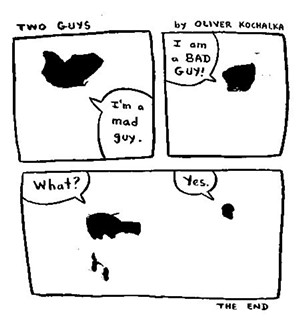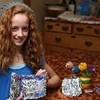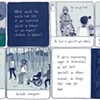Published July 1, 2012 at 4:00 a.m.
Back in the day, kids saved money to buy floppy comic books. Today, it's graphic novels — a longer, more literary form of the genre. Like comics, graphic novels use a combination of dialogue and illustration to tell action-packed tales, sci-fi sagas or autobiographies. They might be funny, serious, sad or even poetic — which is why they're so much fun to make. So what do you need, besides an active imagination, to create a graphic novel with your kids?
"All you really need is paper, a pencil and an eraser," says Vermont's first-ever cartoonist laureate, James Kochalka, author of the all-ages graphic novel series Johnny Boo. To get started, it's a good idea to provide young graphic novelists with a pre-drawn grid of panels, so they can spend more time creating stories and less time struggling to keep their panels straight. Simply fold a sheet of paper in half to create two pages. Then draw just one panel per page.
Kids in third grade and up can draw and write in smaller panels. Fold three or four pieces of paper in half, then draw three rows of two panels on each page. Voilà! There's a template for a six- to eight-page graphic novel.
So what's next?
For cartoonists of any age, it's important to talk through the whole story before you start drawing. Kochalka recommends that parents "ask lots of questions, like, 'What happens next?'" Then they can read through completed pages with their child, and if they come across a gap in the plot, ask for details about how one panel led to the next. The child's answers become content for the page in between.
Kochalka's No. 1 tip for all budding graphic novelists and cartoonists: Always write the words first and then draw the word balloons. "The success rate and readability will go up 1000 percent!" he says.
But kids don't have to go it alone. Vermont artist Peter Wallis has taught children age 8 and up to make graphic novels at Barre's Studio Place Arts, using a curriculum he adapted from his own experience as a student at the Center for Cartoon Studies in White River Junction. His high-energy, multi-age classes can get "a little hectic and crazy," he says, because the kids take the characters to the "zaniest, weirdest places in their imaginations!"
As a warm-up, each class starts with a few drawing games. Then, Wallis introduces three characters for their collaborative graphic novel: "It's always a boy, a girl and a dog," he says. Wallis decides what the characters look like, so students can hit the ground running. Then, taking turns and building off one another's stories, each kid creates one scenario starring those characters.
Then comes the fun part: fleshing out the scenarios they've created, "focusing on the details," says Wallis. "Students rough out [each individual segment and] ink it in." When a page is complete, Wallis scans it into PhotoShop and teaches the kids digital techniques such as color overlays. In a daylong class, each student completes one or two pages. If they have time, the students create a print to use as the cover.
Kochalka and Wallis agree that graphic novels can be amazing educational tools, especially for kids who aren't inspired by more traditional teaching methods to read or write stories.
"Anytime I've gone into a classroom to teach," says Kochalka, "the kids explode with creativity in the weeks afterward. Moving words around is fairly abstract, and anchoring words to pictures helps kids understand the story."
What You Need:
Paper, a pencil, an eraser, a ruler and at least 20 minutes. Choose inspiring graphic novels and cartoons, which you can find at most libraries, and set aside time for discussion and listening.
Where to Go:
You can find classes in graphic-novel making for kids at:
- Davis Studio in Burlington, davisstudiovt.com
- Studio Place Arts in Barre, studioplacearts.com
- Center for Cartoon Studies in White River Junction, cartoonstudies.org
This article was originally published in Seven Days' monthly parenting magazine, Kids VT.
More By This Author
Speaking of...
-

From the Center for Cartoon Studies to 'Watership Down,' James Sturm Can't Stop Creating Worlds
Nov 29, 2023 -

A Middlebury College Professor Uses Graphic Novels to Breathe New Life Into the Study of History
Sep 27, 2023 -

Waitsfield Cartoon Show Features Comic Relief and Revelations
Sep 13, 2023 -

Williston's Champion Comics & Coffee Combines Two of Nerdom’s Favorite Things
Apr 12, 2023 -

Tillie Walden Becomes Vermont's New Cartoonist Laureate
Apr 12, 2023 - More »
Comments
Comments are closed.
From 2014-2020, Seven Days allowed readers to comment on all stories posted on our website. While we've appreciated the suggestions and insights, right now Seven Days is prioritizing our core mission — producing high-quality, responsible local journalism — over moderating online debates between readers.
To criticize, correct or praise our reporting, please send us a letter to the editor or send us a tip. We’ll check it out and report the results.
Online comments may return when we have better tech tools for managing them. Thanks for reading.















































